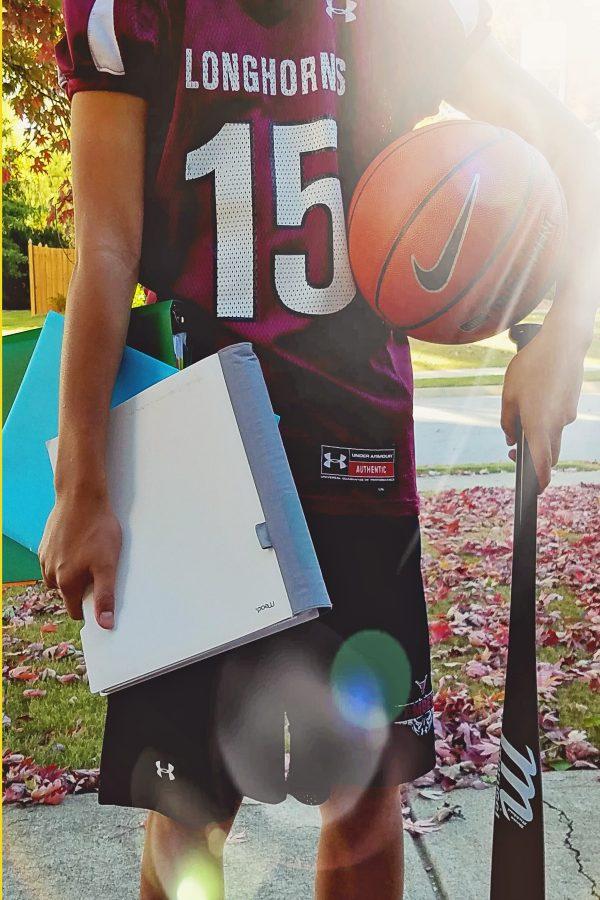Under Pressure: Insight into the life of a student athlete
Consider the label “student athlete” and think about what that means. In Hollywood, jocks are portrayed as the popular kids with little intellectual capacity and only concerned with winning their next big game. However, in recent times the term has taken on a new meaning. With youth sports becoming increasingly more competitive and kids starting to play at younger ages, more and more students are participating in high school athletics and the competition is gaining a different advantage.
No longer can athletic ability alone guarantee you a spot on the team. Long gone are the days when being an athletic intellectual was considered an oxymoron. Nowadays, the ability in the classroom matters just as much as the ability on the field.
Speaking as a student athlete, I can tell you what that means to me. Student first, athlete second. My academics come before my athletics, then everything else takes a backseat. I strive to excel on and off the field. Sometimes this need to be perfect almost manifests itself into a sickness. This is my edge, and something I think all student athletes face at one time or another— the desire for perfection in everything that I do.
However, with those goals come with harsh realities. Most think that athletes only care about games and not books, but that’s really not true. The typical student athlete is among one of the hardest working students you will find in high school. They care just as much about their GPA as they do about their win-loss record, and most likely even more.
A survey conducted of 67 Lambert student athletes have found the following:
Average of 13.5 hours/week with a high of 30 hours spent on athletics.
Average of six hours of sleep per night with several reporting between 4-5 hours. The recommended amount of sleep for a teenager is 9.25 hours.
Around 60% of respondents said it is difficult to manage school and sports, with half of those indicating that it is extremely difficult.
The truth is, student athletes are used to facing the demands on the field with practices, games, and the pressure to perform at the highest level. That kind of drive and commitment to do your best carries over to academics as well, and can often be a reason many high-achieving student athletes are susceptible to mental anguish, added stress, and clinical depression.
Trying to balance school, sports, and a social life is hard. Something usually suffers. Based on the recent sample study conducted at Lambert, it appears that sleep is being sacrificed. Lack of sleep leads to performance issues, mood swings, and anxiety. Try to make up sleep, and you don’t have time to do homework or study. It’s a vicious cycle and some can learn to adapt, while others crumble.
Take the case of Madison Holleran, a 19-year old University of Pennsylvania student. On the evening of January 17, 2014, she fell to her death after running off a 9th story parking garage in Philadelphia. On the outside she was a star athlete in soccer and track and field with a scholarship to an Ivy League school, perfect grades, supportive family, tons of friends, and pretty much the envy of every girl in her school. But inside she was struggling to keep up with appearances, which were not at all what they seemed.
This extreme side of the pressures of student athletes is a real thing and becoming all too common. The perception of having it all together and presenting an ideal life to others is a bar that no one can live up to. Student athletes face this kind of intense stress and it’s up to parents, teachers, and coaches to recognize the load that they carry on their plate.
These are people of influence in a student athlete’s life that can play a vital role in helping them set expectations and manage stress. Although survey results show that most coaches and teachers at Lambert are understanding of the other activity’s commitment, a third of the responses strongly disagreed, which means that there is still work to do in this area.
Allowing themselves to fail or make mistakes or lose games is tough enough on its own. Add the visibility that social media brings, and all those conscious flaws are multiplied. Nobody is leading the edited lives they portray on Instagram. The reality is that everyone faces pressures from the demands that are placed on them from every direction. Student athletes have to learn to let go of what their parents request, what their teachers require, what their coaches demand, and what their friends think, and set expectations according to their own definition of success.
Just navigating high school by itself is hard enough. Imagine trying to tackle AP classes, sports, service, clubs, and a social life on top of that, and sometimes The life of a student athlete is anything but easy. I have to remind myself the end goal is not an Ivy League or a Division I scholarship. It’s a happy, purposeful life. I would rather be exhausted doing something I love, than be tired from doing something I’m not passionate about. Am I sometimes overcome with anxiety? A lot. Do I try my best not to let my teammates, coaches, teachers, parents, and friends down? All the time. Is it worth it all? Absolutely.
Your donation will help support The Lambert Post, Lambert High Schools student-run newspaper! Your contribution will allow us to purchase equipment and cover website hosting costs.








